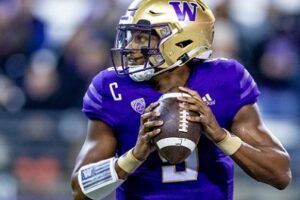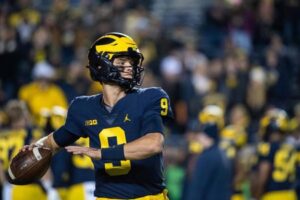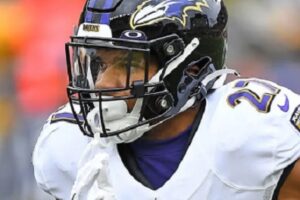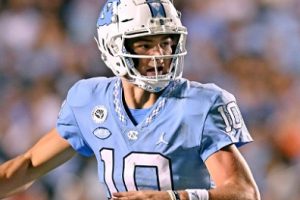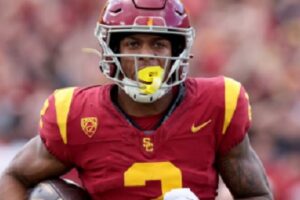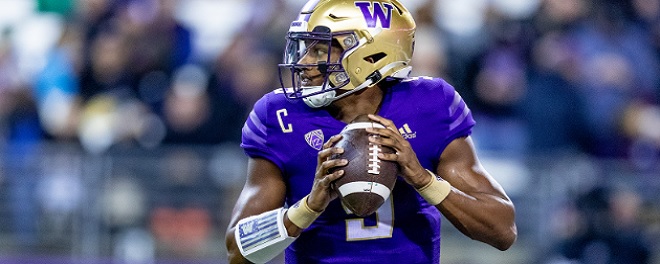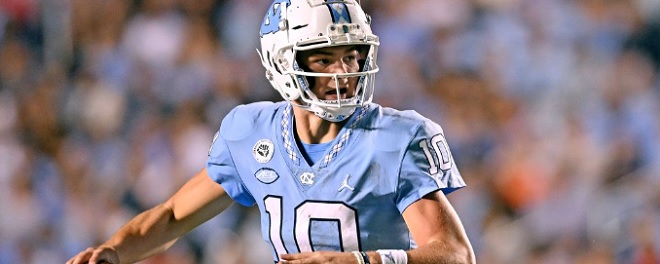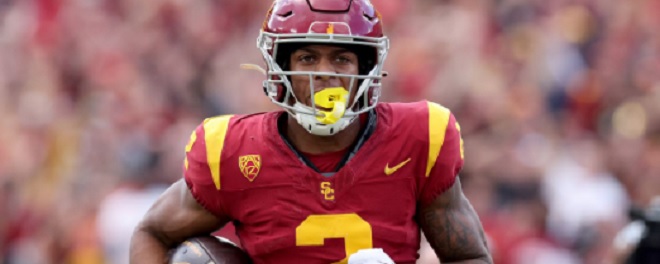By Charlie Campbell.
Send Charlie an e-mail here: [email protected]
Follow Charlie on Twitter @draftcampbell for updates.
This page was last updated March 24, 2022. Follow me @walterfootball for updates.
Position Review: Quarterbacks
Quarterback Class
Early-round talent: C+
Mid-round: D
Late-round: D
Overall grade: C-
Merging the 2022 and 2021 prospects
Trevor Lawrence
Zach Wilson
Trey Lance
Justin Fields
Mac Jones
Kenny Pickett
Malik Willis
Sam Howell
Matt Corral
Kyle Trask
Desmond Ridder
Kellen Mond
Carson Strong
Just to be clear this article and series is all my opinion based off my own study and information I’ve gotten from general managers, directors of college scouting, national scouts, area scouts, and NFL coaches who know way more than I do.
This is a weak class of quarterback, with two likely to go in the first round. Two or three more are likely to go on the second day, and then a couple more in the mid-rounds. Obviously, this class is nowhere close to being as talented as the 2021 group that saw five quarterbacks go in the top half of the first round.
If you were to merge the two classes together, Kenny Pickett and Malik Willis, this year’s top quarterback prospects, would go behind Mac Jones. Sam Howell and Matt Corral are second-round-caliber prospects similar to Kyle Trask. Desmond Ridder is a third-rounder similar to Mond, with Carson Strong behind Mond as a mid-rounder.
Safest Pick: Kenny Pickett, Pittsburgh

Previous Picks:
2021: Trevor Lawrence
2020: Joe Burrow
2019: Daniel Jones
2018: Sam Darnold
2017: Pat Mahomes
2016: Carson Wentz
2015: Jameis Winston
2014: Derek Carr
2013: Geno Smith
My track record here is pretty good. The 2013 class was a wash because there have been zero good quarterbacks to emerge from that year, so I’m not beating my chest that Geno Smith managed to stick in the NFL as a backup. At the time, however, I was smarter than the Buffalo Bills brain trust that took E.J. Manuel with the 16th-overall pick of the 2013 NFL Draft. I’m proud that I picked Derek Carr over Blake Bortles, Johnny Manziel and Teddy Bridgewater, who all wrongly went ahead of Carr in the 2014 NFL Draft. Derek Carr has turned into a good starting quarterback, while the other three were disappointments for the teams that drafted them.
Jameis Winston has been a decent starter, but is not as good as he was expected to be. Carson Wentz helped get Philadelphia a Super Bowl championship, but his career was fallen off a cliff. Right now, Mahomes is among the very best quarterbacks in the NFL, and he led his team to a Super Bowl Championship during his rookie contract. Thus, I’m proud I picked Mahomes to be a safer pick than Mitch Trubisky and Deshaun Watson.
This year, my choice was pretty easy because Pickett is the safest of the quarterback prospects to turn into a quality starter. He is an accurate passer with mobility, size and a quality arm. He also makes good decisions and plays in the clutch.
Biggest Bust Potential: Desmond Ridder, Cincinnati

Previous Picks
2021: Mac Jones
2020: Jordan Love
2019: Kyler Murray
2018: Mason Rudolph
2017: Mitch Trubisky
2016: Connor Cook
2015: Brett Hundley
2014: Johnny Manziel
2013: Mike Glennon
My track record here is pretty good. Obviously, it is too early to make a judgment on Jones or Love, but Jones got off to a good start in his rookie season. Rudolph and Trubisky were busts for the Steelers and Bears, respectively. Cook fell out of the NFL, but as a third-day pick, he was only expected to be a backup, so he really isn’t considered a bust. Hundley was a backup, at best, in the NFL. I was right about Manziel having bust potential. Glennon was a bust as a starter, but is a backup journeyman.
Some in the media have projected Ridder to be a first-round pick. While he has a good skill set with size, arm strength, and athleticism, he needs a lot of refinement as a pocket passer and must become more accurate for the NFL. Ridder could end up being a backup-caliber quarterback, which would make him a bust if a team spends an early-round pick on him.
Quarterback Rankings by Attributes
Accuracy:
NFL prototype: Aaron Rodgers, Packers
- Kenny Pickett
- Sam Howell
- Malik Willis
- Carson Strong
- Matt Corral
- Desmond Ridder
Recap: The most important characteristic for any quarterback in the NFL is accuracy. Not only do accurate quarterbacks reduce turnovers and maintain time of possession, they increase the opportunities for skill-position players to make bigger impacts. Thus, accurate signal-callers will give teams more return on their dollars with high-priced wide receivers. It takes an accurate quarterback to be a weapon as a pocket passer, and the elite quarterbacks are able to beat good coverage with precision passes into tight windows.
Accuracy is one of Pickett’s biggest strengths. He is a very accurate passer who can beat good coverage with the placement of his passes. Pickett can to fit the ball into tight windows and does a superb job of hitting his receivers on the run to lead them for more yards. Pickett has natural accuracy and throws a very catchable ball.
There is no doubt that Howell is an accurate passer. Howell regularly places his ball well, putting it in position for his receivers to make catches while avoiding putting the pass in danger of being intercepted. Howell threw the ball on the money downfield over his three seasons with North Carolina and was accurate at all levels of the field. Howell’s accuracy is one of his best traits and provides some hope for him to become a starter as a pro.
Overall, Willis has good accuracy, and his deep-ball precision is very impressive. Willis lofts passes downfield to lead his receivers over the top of coverage consistently. Willis also shows the ability to function in the quick passing game in the short part of the field, firing some quick bullets into smaller windows to move the ball. He could stand to improve his footwork for the NFL, and doing so will make him more accurate.
Strong can push the ball vertically downfield and is an accurate passer to all levels. He shows good timing and precision on his throws to lead receivers to yards after the catch. With his quality precision, Strong is able to loft in throws into tight windows and beat good coverage through the location of his passes. Strong can be a bit conservative, and he has a tendency to underthrow some passes to ensure the reception is made rather than risking an incompletion by sailing the ball over the head of his receivers.
Corral flashes some accuracy, but could stand to develop his placement. Corral seems wary of overthrowing receivers at times, so that leads to him overcompensating with his ball placement and leaving it a little off. He has a tendency to have passes fall a little short, behind, or low in order to make sure he gets the completion. That leads to receivers reaching and behind at times to make the catch. If Corral improves his timing, it could help to improve his ball location. Improving would also help him to throw receivers open and lead his receivers for more yards after the catch.
Ridder is not an inaccurate, but it is also not an impressive strength. His accuracy got better in his final season of college, but he still has room for improvement for the NFL.
Arm Strength:
NFL prototype: Pat Mahomes, Chiefs
- Malik Willis
- Desmond Ridder
- Kenny Pickett
- Sam Howell
- Matt Corral
- Carson Strong
Recap: A quarterback having the strongest arm doesn’t always mean that much, but there are throws that big-armed quarterbacks can make that average quarterbacks can only dream of making. So a powerful arm is another weapon that can lead to points, wins, and miserable days for defenses.
Willis has the strongest arm in this draft class, and second place really isn’t close. Willis is a well-built quarterback who has an absolute cannon. The ball explodes out of his hand and carries effortlessly downfield. Willis’ elite arm can make all the throws required and the ability to beat good coverage with the velocity of his passes. He instantly will be one of the stronger-armed quarterbacks in the NFL.
Ridder and Pickett have strong arms and can really spin it. That was clearly seen by area scouts, and both players impressed with the power of their throws at the combine and Senior Bowl. Ridder will put a lot of spin on the blal and has the arm to make all the throws in the NFL. Pickett can really fire some fastballs into tight windows.
Howell does not have a cannon like Willis, but his arm looks plenty strong enough for the NFL; it won’t be a problem. Corral has a strong arm and is capable of going vertical to challenge defenses downfield. He is able to spin the ball to fire fastballs into tight windows in the short to intermediate part of the field. Strong possesses a quality arm for the next level with the ability to loft the ball deep down the field, but his arm strength can lag when he has to drive a fastball into a tight window in the short to intermediate part of the field.
Field Vision:
NFL prototype: Aaron Rodgers, Packers
- Kenny Pickett
- Matt Corral
- Carson Strong
- Sam Howell
- Malik Willis
- Desmond Ridder
Recap: Field vision is one characteristic that separates the elite quarterbacks of the NFL. Quarterbacks who throw a lot of interceptions are inclined to lock onto their primary reads and stare down receivers. Signal-callers with good field vision can quickly work through their progressions and see more than a receiver on a route. They also can help get wideouts open by looking off safeties and playing games with their eyes. Many college quarterbacks enter the NFL with subpar field vision and have to improve this at the next level.
Coming from a pro-style system under Mark Whipple, Pickett shows advanced field vision to work through his progressions and read defenses. He had his offense mastered and knew where his receivers are going to be. Pickett will make his reads at a good pace rather than slowly scanning through the defense. Entering the NFL, Pickett has well-developed field vision.
Corral has the ability to work off his first read, and he showed improvement in 2021 with how he surveyed defenses. Ole Miss’ offense had some plays predetermined, and Corral needs to get faster working through progressions and working off his first read. That should come with time, but he has potential.
With his thick build and good height, Strong hangs tough in the pocket, standing tall and surveying the field with advanced field vision. Strong works off his primary read and sees the field well.
In the pocket, Howell shows the ability to work off his primary read and does not panic when his first read is covered. Howell’s timing, anticipation, accuracy and field vision are on point to be an effective pocket passer. Speeding up his reading of defenses and working through his progressions faster are points of emphasis.
Willis has some raw elements to his game as a passer and needs development. The biggest point of improvement is field vision. He has to get better at reading defenses, working through his progressions, and throwing the ball to the right receiver. With his lack of height, Willis can get blinded by the line and fail to see the field well consistently. Willis can have a tendency to stare down his primary read and predetermine where he is going with the ball. He has get better at working through reads and get fast at it for the NFL.
There are significant flaws in Ridder’s game entering the pros. His field vision being a major point of improvement. Far too often, he would lock his eyes on his primary read and not move them away. He would often stare down targets and not look off defenders. When Ridder did scan the field, it wasn’t fast enough for the NFL and he held the ball so long. That could be seen at Senior Bowl, where he took some unnecessary sacks. Reading the field, working through his progressions, and making good decisions are the key points for Ridder’s development.
Decision-Making:
NFL prototype: Aaron Rodgers, Packers
- Kenny Pickett
- Sam Howell
- Carson Strong
- Malik Willis
- Matt Corral
- Desmond Ridder
Recap: Pickett’s decision-making was vastly improved as a senior. With his field vision and intelligence, Pickett consistently made good decisions and demonstrated the ball security to avoid turnovers. There were times, however, maybe two or three throws a game, when he seemed to slip into a gunslinger mentality, so that is something for him to work on in the NFL.
For two out of three seasons, Howell made safe steady decisions, but his decision-making declined in 2021, likely due to how much talent North Carolina had lost to the 2021 NFL Draft. Howell made a few poor decisions in 2021 out of pressing and trying to do too much.
Strong was a solid decision-maker overall. Willis and Corral are mixed bags. In the majority of games, Willis did a good job of decision-making, but he had a few rough performances. Corral was better in 2021 than in 2020, when he had some epic meltdown games.
Ridder improved as a decision-maker over his years as the Bearcats starter. He relapsed at times, but overall, he looked much better in terms of ball security and throwing the ball to the right receiver.
Mobility:
NFL prototype: Lamar Jackson, Ravens
- Malik Willis
- Matt Corral
- Desmond Ridder
- Kenny Pickett
- Sam Howell
- Carson Strong
Recap: Mobility is important to help a team’s offensive line and wide receivers. As read options, spread offenses, and up-tempo concepts continue to grow in the NFL, mobility will continue to be a sought-after attribute for pro quarterbacks. The top-five quarterbacks in this group all have good mobility. Strong is really the only quarterback in the group who is not a dangerous runner.
To go along with his big arm, Willis is a true dual-threat quarterback thanks to his dangerous running ability. He has the quickness to dart upfield and good speed, for a signal-caller, to accelerate and run away from some defenders. With his athletic scrambling ability and big arm, Willis is a dangerous threat to ad lib and make big plays on roll outs. Making plays off script in backyard football is an en vogue trait, and Willis showed a similar ability with Liberty. As a runner, Willis is tough and will lower his shoulder to run through contact. As a pro though, he is going to need to cut down on that to avoid injury.
Corral can hurt defenses with athleticism and running ability. He is a real threat to pick up yardage on the ground, showing a burst as a runner and some surprising elusive moves in the open field. It isn’t all that common to see SEC defenders getting juked by a quarterback, but Corral did that regularly in 2020. On top of elusiveness, Corral is a tough runner who lowers his shoulder and tries to pick up yards after contact. In the professional game, that might need to be reduced because he took some big hits in college rather than sliding more, which would help protect him from injury.
Ridder some mobility to move around as well. When plays break down, he can use his feet to buy time, and he makes some passes off platform. Ridder’s quickness and athleticism present a threat to hurt defenses on the ground.
Pickett does a good job of using his feet when plays break down or nothing is open downfield. It is an added element to his game that makes him more dangerous and effective. He has quickness and athleticism to dodge pass rushers and can rip off yards in chunks because defenses can sleep on his running ability. Pickett is very wise about when he runs and does not look to take off when his first read is covered.
Howell is a good athlete with enough quickness to get yardage on the ground. His mobility and athleticism let him buy time and escape sacks. Howell is a capable runner with the ability to dodge defenders, but he is more of a pocket quarterback who only runs when he has to. He is not an aggressive runner in the open field.
Strong isn’t a terrible athlete, but he is not a running threat given the speed of NFL defenders.
Intangibles:
NFL prototype: Joe Burrow, Bengals
- Malik Willis
- Kenny Pickett
- Sam Howell
- Desmond Ridder
- Carson Strong
- Matt Corral
Recap: Team sources rave about the intangibles with Willis and Pickett. Both of them interviewed well at the 2022 NFL Scouting Cobine and are known to be hard workers, students of the game, good teammates, and leaders. Both Willis and Pickett have drawn reviews for their intangibles.
Ridder, Howell and Strong are also said to have good intangibles. Howell has interviewed well, although some sources say there are some who find him to be a little cocky. Corral had maturity issues early in his college career, but it sounds like he grew out of them.
2024 NFL Mock Draft - April 16
NFL Power Rankings - Feb. 22
Fantasy Football Rankings - Feb. 19
NFL Picks - Feb. 12

